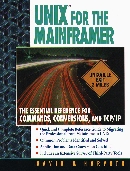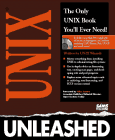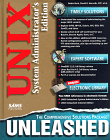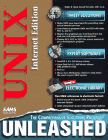 UNIX for the Mainframer
UNIX for the Mainframer
I currently have one book being published under my name, was working on another (but had to kill the project when my co-author abandoned me), have contributed chapters to a bunch of them, and have been asked to contribute chapters to others.
I am currently working on a number of proposals for additional ones. I am always interested in speaking with Editors with ideas (or interest in learning more about the proposals below). I can also assist with books in need of chapters.
 UNIX for the Mainframer
UNIX for the Mainframer
Summaries for these book ideas are available here; if you would like more information, contact me for a full proposal.
The original title was "UNIX and TCP/IP for the Mainframer" being published by CBM (Cardinal Business Media) Books in Horsham Pennsylvania under ISBN 1-878956-64-7. Unfortunately, CBM decided to get out of the book business about the time my book was supposed to go to the printer (September 1996). The last time I spoke with them, they are still getting orders for the book (which they are forwarding).
It took a few months to find a new publisher and now PTR/Prentice-Hall is publishing the book under the new title. The book was published and reached the warehouse August 20, 1997. It should be coming to a book store near you. If it is not in stock, you can always order it using the new ISBN:0-13-632837-7.
LCIS (Library of Computer and Information Sciences), a Newbridge Book Club, selected this book as an alternate selection in the September 1997 newsletter.
This book is written for the mainframe professional who has to use UNIX and is just a little afraid of the process. It covers commands, shells (in place of JCL), editors, making the transition, networking, data conversion, and the real meaning of the error messages. Yes, I admit to having done quite a bit of mainframe work, but now I do mostly UNIX, open systems, client server, and relational technologies. I started out just helping a few co-workers who had to make the transition and were dreading it. The final result is this book!
See my book and interview at Amazon.com (old title). This book is not actually available since Cardinal is no longer publishing.
See the Cover (4x5 inches, 128Kb) or (7x9 inches, 271Kb); you can also see me holding the book (1141x1177 pixels, 106Kb).
Copies Sold ![]()
I have loaded the source code from the appendices so you do not have to type them in yourself. This is also the place to find any errata.
Cardinal's Home PageThe second edition was a major rewrite, revision, and update to the original "UNIX Unleashed" book published by SAMS in 1994. The original ISBN was 0-672-30402-3; for the second edition, there are two volumes: System Administrator Edition, ISBN 0-672-30952-1 and Internet Edition, ISBN 0-672-31205-0.
I strongly recommend purchasing the second edition because there were a number of misprints and missing portions in the first edition that have been cleared up. In addition, there are chapters on the Internet, HTML, Database server setup, and many other areas. Even if I was not involved with this effort, I would still recommend the second edition over the first.
I corrected and revised the chapters on writing tools (nroff/troff, pic, tbl, eqn/neqn, and others) reducing it down to four chapters while still covering the necessary parts. These tools are less important now that just about everyone has a GUI/WYSIWYG word processor on their desk top.
I corrected and revised the awk programming chapter. I love awk and use it a lot in my daily work - it makes my job much easier!
I wrote the (new) chapter on HTML - Hyper Text Markup Language. I also wrote the (new) chapter on Using CGI-BIN with Shell Scripts (not the best practice, but included in the book for completeness) and the chapter on Using CGI-BIN with C/C++. I ended up revising several of the chapters in the Internet section to make them flow better and reduce duplication.
I wrote most of the Glossary and coordinated the rest from the authors of the other chapters in the book. I also recruited a number authors from my client site and other consultants from CGI Systems. Because of all my work on this book, I received cover credit (my name is on the cover and I get to include a dedication and acknowledgements - in addition to the biography material all authors get to include).
The second edition became avaiable during December 1997.
This book is designed to be a one-stop shopping expedition - pick up this UNIX book and you may not ever need another!
 See the First Edition at Amazon.com (may be out of print)
See the First Edition at Amazon.com (may be out of print)
 See the Second Edition, System Administrator Edition at Amazon.com
See the Second Edition, System Administrator Edition at Amazon.com
 See the Second Edition, Internet Edition at Amazon.com
See the Second Edition, Internet Edition at Amazon.com
See the Second Edition, Internet Edition translated into Russian!
I found this when I was looking for
my name.
The Third Edition (ISBN 0-672-31411-8) is an revision, update, and condensed version of the two volume UNIX Unleashed Second Edition (System Administrator Edition and Internet Edition) was published by SAMS in 1997. The two volume set did not sell very well (personally, I'm not surprised as each volume listed for close to US$60), so this version is only one volume with extranous material removed.
You'll have to review your own needs to determine whether this edition is better than the two volume second edition. Some material has been eliminated and some drastically reduced. This edition may be more cost effective for you than the second (but look for yourself).
I revised and contracted the chapters on writing tools (nroff/troff, pic, tbl, eqn/neqn, and others) reducing it down to one chapter covering the highlights. These tools are less important and their use is declining now that just about everyone has a GUI/WYSIWYG word processor on their desk top.
I rewrote the awk programming and CGI-BIN chapters. I revisied the HTML chapter.
I wrote most of the Glossary (I keep growing it with each revision or UNIX book I work on with SAMS/Que). Because of all my work on this book, I was included in the lead author's acknowledgements (I did not get cover credit) -- in addition to the biography material all authors get to include.
The Third Edition became avaiable in December 1998.
See the Third Edition at Amazon.com
Macmillan (parent of SAMS) Home Page
The second edition was a major rewrite, revision, and update to the original "Red Hat Linux Unleashed" book published by SAMS in 1994. The original ISBN was 0-672-30962-9, for the second edition, it is ISBN 0-672-31173-9.
The second edition is a complete rewrite of the first edition that is much improved in my mind. There are new chapters on the Internet, HTML, and many other areas. Even if I was not involved with this effort, I might recommend the second edition over the first.
I wrote the "gawk Programing" chapter. I revised the (new) C/C++ chapter and the glossary from UNIX Unleashed, 2nd edition for inclusion in this book. I also wrote an "Introduction to CGI-BIN" but the web section was dropped due to page count.
Because of my involvement with UNIX Unleashed, 2nd edition and the work I did on this book, I was offered cover credit, but I declined since my role was reduced (I was originally supposed to write another three chapters that were cancelled, in addition to the CGI-BIN chapter.
This book is designed to be a one-stop shopping expedition - pick up this book about the Red Hat Linux distribution and you should not need another!
This book is avaiable as of January 1998.
 See the First Edition at Amazon.com
See the First Edition at Amazon.com
 See the Second Edition at Amazon.com
See the Second Edition at Amazon.com
The third edition was an update to the second edition. I did not write or revise any of the chapters in this edition although I am listed in the "contributing authors" section and am listed as one of the authors by Amazon.com. My material from the second edition was included (revised by the lead authors). I do not have a recommendation either way (to buy or not to buy).
See the Third Edition at Amazon.com
The fourth edition is a major update to the third edition. The name is actually "Red Hat Linux 6 Unleashed" to emphasize the Linux release version. I revised several chapters in this edition. You should get this edition if you want to work with the latest version of Red Hat!
See the Fourth Edition ("Red Hat Linux 6 Unleashed") at Amazon.com
"Red Hat Linux 7 Unleashed" was the next edition of this book -- for release 7 of Red Hat Linux. I revised several chapters in this edition.
"Red Hat Linux 7.2 Unleashed" is the new edition of this book for release 7.2 of Red Hat Linux. I revised several chapters in this edition. You should get this edition if you want to work with the latest version of Red Hat!
Macmillan (parent of SAMS) Home Page
This is a complete rewrite of the original "Using UNIX" book published by Que in 1994. The original ISBN ("Special Edition") was 1-56529-619-2, for the revised edition, it is ISBN 0-789-71632-1. The ISBN for this edition is 0-78971-632-1.
This revised edition is a complete rewrite of the first edition and is much improved. There are new chapters on the Internet, HTML, and many other areas. Even if I was not involved with this effort, I might recommend this edition over the first.
I wrote the "awk Programing" chapter, revised the glossary from UNIX Unleashed, 2nd edition for inclusion in this book.
It should be coming to a book store near you second or third quarter 1998.
This book is designed to be a one-stop place to learn how to use UNIX. UNIX Unleashed is much more technical than this volume.
Macmillan (parent of SAMS) Home Page
This is an introductory book of Shell Programming under UNIX. My involvement was limited to a couple of chapters only.
This book became available March 1999.
This book is designed to be a starting point for shell programming.
Macmillan (parent of SAMS) Home Page
The fourth edition was a major update to the Third Edition.
I continued with some of my UNIX Unleashed and Red Hat Linux Unleashed chapters into this book. Gawk, C/C++, Perl, and Network Programming seem to be my writing specialties in these series.
This edition became avaiable during December 1999.
This book is designed to be a one-stop shopping expedition - pick up this Linux book and you may not ever need another!
See the Fourth Edition at Amazon.comMacmillan (parent of SAMS) Home Page
This book will teach you C++ as used under Linux -- the GNU compilers. It became available late in the Spring of 2000. It is based on Teach Yourself C++ in 21 Days by Jesse Liberty. After all, there are just so many ways to explain the "while" loop. The ISBN is is 0-67231-785-4.
This book is different from Jesse's book in that it focuses on using the GNU compilers under Linux. It also shows how you can use some versions of the GNU compilers on other platforms (like MS-DOS if you want to work on a problem at work on only have access to Windoze).
This book is designed to be a one-stop place to learn C++ with the GNU toolset (usually used under Linux).
See Jesse Liberty's Teach Yourself C++ in 21 Days at Amazon.com
See Peter Aitken's & Bradley L. Jones' Teach Yourself C in 21 Days at Amazon.com
Macmillan (parent of SAMS) Home Page
This is a new incarnation of "Using UNIX, Second Edition" book published by Que in 1998.
My material was included without my involvement, so I can't be sure which parts are mine. In the earlier incarnation, I wrote the "awk Programing" chapter and glossary.
This book was published in December, 1999 with a 2000 copyright.
This book is designed to be a one-stop place to learn how to use UNIX. UNIX Unleashed is much more technical than this volume.
Macmillan (parent of SAMS) Home Page
The second edition was a major update to the First. Many changes were needed and complete chapters were replaced with new versions.
I originally started out revising the TCP/IP, UDP, and Multi-casting chapters, but when the decision was made to scrap the original material (completely new chapters instead of just cleaning up the old ones), that work was discarded. I then committed to write new versions of the TCP/IP and UDP chapters, but another author mistakingly wrote the TCP/IP chapter before I finished mine. So I ended up contributing only the UDP chapter.
This edition should be avaiable during December 2000.
See the Second Edition at Amazon.comMacmillan (parent of SAMS) Home Page
This book largely is targeted for the same folks who might buy "UNIX for the Mainframer" but with a slight difference: it would come with a copy of Linux and focus on Linux instead of "generic" or multiple versions of UNIX. This allows the reader to build skills they need to grow professionally on their own time at home.
This book is written for the mainframe professional who has to use UNIX and is just a little afraid of the process. It covers commands, shells (in place of JCL), editors, making the transition, networking, data conversion, and the real meaning of the error messages. Yes, I admit to having done quite a bit of mainframe work, but now I do mostly Linux, UNIX, open systems, client server, and relational technologies.
This book is targeted for technical professionals and managers looking to use the UNIX capabilities on the Mainframe. Those capabilities include OMVS (Open MVS - under TSO), AIX, and most recently, Linux. Much like "UNIX for the Mainframer", this book takes the reader from their current skill environment to the new one.
This book is targeted for technical professionals and managers who are migrating applications that run on UNIX systems to what may be the open system of the future: Microsoft Windows NT.
More and more systems are being marketed by hardware vendors that will run WIN NT - everything from a desktop PC, super PC/workstation, organizational server, to systems that can support large organizations like the DEC Alpha systems.
There are multiple approaches to migrating applications from UNIX to WIN NT: drag and drop (move the application with minimal changes a.k.a. direct port), retechnology (move the application and modify to use new database, user interface, and interprocess communication technologies), and others. Each approach has attendant problems, risks, costs, and issues - each would be reviewed and contrasted.
This book was supposed to be part of the Marshall Brain series of NT books published by PTR/Prentice-Hall. Mike Meehan was the Acquisition Editor for this (he is also my editor for "UNIX for the Mainframer"). The book was scheduled to be out by December 1999. I'm not sure what the ISBN would have been.
Keith Parmer was my co-author for this book until he abandoned me. Can you tell I'm a little peeved about this?
This book is targeted for senior technical professionals and managers who are affiliated with organizations that are beginning to migrate legacy systems from the mainframe to other platforms. Both technical and organizational issues are discussed.
The reader is directed through a number of questions for the different approaches including: why, how, which approach is best for the specific application, and even if the migration should occur at all. The processing requirements of a specific application can limit the migration choices available; this information is not readily available to the professionals from either the source or target environments - only to those who have migrated applications.
This book is targeted for technical professionals of all levels who are primarily involved with PC's using operating systems such as MS/PC DOS, MS Windows, or OS/2 who are interested in learning about UNIX and TCP/IP networking.
There command processors available for MS/PC-DOS, MS Windows, and OS/2 that provide an interface that looks and behaves like a version of the UNIX operating system. MS WIN NT includes a POSIX (a UNIX standard) compliant command processor.
This book is not intended to make someone an expert on UNIX - that is too broad a topic and there are a number of good books on UNIX overall and specific subsystems (i.e. NFS, FTP, TCP/IP). The purpose is to help the PC user or professional make the transition to open systems and be productive rapidly - to build on the existing skill base to move to a new environment.
This book is targeted for a wide variety of people - from the computer novice who is confused by all the strange terms and acronyms to the technical professional who finds acronyms in books and magazine articles that are unfamiliar.
What makes this book special is the availability of a quarterly updates subscription service. There are always new terms and acronyms in the computer field; the update service prevents the book from becoming outdated.
The idea from this book actually came from a former-lawyer/new technical recruiter. In his field there are such publications as this one; he found himself having to learn all kinds of terms the hard way (by osmisis).
This book is targeted for technical staff and managers who are involved with hiring, managing, and leading technical professionals. It also helps technical professionals identify problems in their organization and work to improve them.
This is an organizational or people book, not technical.
It is much easier to identify the factors that cause people to avoid or leave organizations than it is to identify what attracts and causes them to stay. This book is based on the author's experiences at a number of organizations as an employee and consultant as well as anecdotal evidence from other professionals.
What motivates a technical professional? What attracts them to an organization? What makes them stay with that organization? These all vary by the individual, but the factors that negate these are easily identified by honest conversations with people as they leave.
Many organizations conduct exit interviews attempting to determine the reasons that people leave, but frequently, the answers are tempered with the belief that one should not burn bridges. The feeling is that if truly honest answers were given, the individual would get a poor recommendation in the future or would not be able to return if the decision to leave was a mistake.
In addition to loosing existing staff, if there are significant organizational problems at a company, they will experience difficulty in recruiting new individuals as information about those problems is shared by current and former employees.
This book is targeted for all levels of technical professionals who are involved with creation of applications based on open systems or client/server with a specific focus on existing applications moved from a mainframe.
This is an over-all technical issues book instead of a being about specific tools.
It is much easier to identify the factors that cause application downsizing to fail than it is to identify what causes them to succeed. This book is based on the author's experiences at a number of organizations as an employee and consultant as well as anecdotal evidence from other professionals.
What is a good application to implement as client/server or move from a mainframe? What are some of the organizational and technical pit-falls that occur? Why was the budget and schedule exceeded by so much? These all vary by the project, but the factors that negate these are easily identified by honest conversations with people involved.
Many organizations do not perform postmortem analysis of projects that fail or are seriously late/over budget. Even when they do, the answers may not be accurate due to political pressure, loyalty to a manager, or even fear for ones job.
This book is based on seminar that was prepared for DECUS (Digital Equipment Computer Users Society) and is oriented toward VAX/VMS technical users. The book form would be oriented towards non-mainframe technical professionals (familiar with UNIX, OpenVMS, or PC's) and find themselves working with IBM mainframes. As corporations down-size their applications from mainframes to departmental level computing, the developers (non-mainframe technical professionals) of the new applications still must interact with the mainframe.
When an application is moved from the mainframe, there will still be connections with other applications remaining on the mainframe. These connections must be maintained and data movement verified.
It is very beneficial being multi-system literate and able to talk, program, and interact with the mainframe groups with their "big-blue" equipment.
There are books designed to help a full-time IBM mainframer attain technical expertise. They are intended for technical professionals who access these systems as their primary computers, not on a part-time basis.
This book is targeted for programmers who are familiar with ISAM and VSAM programming techniques who want to learn relational databases and the Structured Query Language (SQL) used with them. ISAM is a generic method of accessing data through indexes (directly based on keys) and sequentially, it is also a specific product on the mainframe that has been superseded by VSAM. Many of the concepts are the same between ISAM and VSAM on the mainframe, just some of the low level details differ; on other platforms (UNIX, PC's, etc.), ISAM is the specific product name.
Learning a new technology is difficult enough without having to learn it independently of prior experience and existing knowledge base. By building on the current ISAM/VSAM knowledge, this book differentiates itself from other SQL and Relational database books on the market.
This book is targeted for programmers who are familiar with IMS programming techniques who want to learn relational databases and the Structured Query Language (SQL) used with them. IMS is a mainframe based hierarchical (CODASYL) database that bas been ported to other platforms including PC's and UNIX (specifically under the IBM UNIX known as AIX).
The mainframe IMS product, conceptually, has two components - IMS-DB and IMS-DC, referring to Data Base and Data Communications (screen handling). This book focuses on the Data Base while providing limited information about replacements for the screen handling.
Learning a new technology is difficult enough without having to learn it independently of prior experience and existing knowledge base. By building on the current ISAM/VSAM knowledge, this book differentiates itself from other SQL and Relational database books on the market.
This book is targeted for technical professionals of all levels involved with writing command procedures (a.k.a. shell scripts) who want to use REXX.
REXX was originally written for use with the IBM mainframe operating system VM; it is now available for MVS, many versions of UNIX, OS/2, OS/400, MS/PC-DOS, and MS Windows operating systems. It is truly not just for mainframes any more.
This book would include an overview of the REXX language and then focus on using it on non-mainframe applications. The are differences between the available REXX versions would be highlighted.
Real world application development using REXX (non-mainframe) would be shown through the use of Inter Process Communication (IPC) and CGI script (part of World Wide Web page processing) examples.
There have been
![]() hits on this page and
hits on this page and
![]() hits on all pages.
hits on all pages.